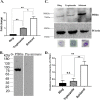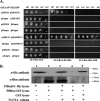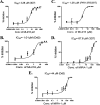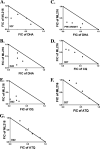Elucidation of DNA Repair Function of PfBlm and Potentiation of Artemisinin Action by a Small-Molecule Inhibitor of RecQ Helicase
- PMID: 33239368
- PMCID: PMC7690958
- DOI: 10.1128/mSphere.00956-20
Elucidation of DNA Repair Function of PfBlm and Potentiation of Artemisinin Action by a Small-Molecule Inhibitor of RecQ Helicase
Abstract
Artemisinin (ART)-based combination therapies are recommended as first- and second-line treatments for Plasmodium falciparum malaria. Here, we investigated the impact of the RecQ inhibitor ML216 on the repair of ART-mediated damage in the genome of P. falciparumPfBLM and PfWRN were identified as members of the RecQ helicase family in P. falciparum However, the role of these RecQ helicases in DNA double-strand break (DSB) repair in this parasite has not been explored. Here, we provide several lines of evidence to establish the involvement of PfBlm in DSB repair in P. falciparum First, we demonstrate that PfBlm interacts with two well-characterized DSB repair proteins of this parasite, namely, PfRad51 and PfalMre11. Second, we found that PfBLM expression was upregulated in response to DNA-damaging agents. Third, through yeast complementation studies, we demonstrated that PfBLM could complement the DNA damage sensitivity of a Δsgs1 mutant of Saccharomyces cerevisiae, in contrast to the helicase-dead mutant PfblmK83R Finally, we observe that the overexpression of PfBLM induces resistance to DNA-damaging agents and offers a survival advantage to the parasites. Most importantly, we found that the RecQ inhibitor ML216 inhibits the repair of DSBs and thereby renders parasites more sensitive to ART. Such synergism between ART and ML216 actions was observed for both drug-sensitive and multidrug-resistant strains of P. falciparum Taken together, these findings establish the implications of PfBlm in the Plasmodium DSB repair pathway and provide insights into the antiparasitic activity of the ART-ML216 combination.IMPORTANCE Malaria continues to be a serious threat to humankind not only because of the morbidity and mortality associated with the disease but also due to the huge economic burden that it imparts. Resistance to all available drugs and the unavailability of an effective vaccine cry for an urgent discovery of newer drug targets. Here, we uncovered a role of the PfBlm helicase in Plasmodium DNA double-strand break repair and established that the parasitic DNA repair mechanism can be targeted to curb malaria. The small-molecule inhibitor of PfBlm tested in this study acts synergistically with two first-line malaria drugs, artemisinin (ART) and chloroquine, in both drug-sensitive and multidrug-resistant strains of P. falciparum, thus qualifying this chemical as a potential partner in ART-based combination therapy. Additionally, the identification of this new specific inhibitor of the Plasmodium homologous recombination (HR) mechanism will now allow us to investigate the role of HR in Plasmodium biology.
Keywords: DNA repair; PfBlm; PfWrn; Plasmodium falciparum; homologous recombination; molecular docking; yeast complementation.
Copyright © 2020 Suthram et al.
Figures









Similar articles
-
Bloom Helicase Along with Recombinase Rad51 Repairs the Mitochondrial Genome of the Malaria Parasite.mSphere. 2021 Dec 22;6(6):e0071821. doi: 10.1128/mSphere.00718-21. Epub 2021 Nov 3. mSphere. 2021. PMID: 34730376 Free PMC article.
-
A small-molecule inhibitor of the DNA recombinase Rad51 from Plasmodium falciparum synergizes with the antimalarial drugs artemisinin and chloroquine.J Biol Chem. 2019 May 17;294(20):8171-8183. doi: 10.1074/jbc.RA118.005009. Epub 2019 Apr 1. J Biol Chem. 2019. PMID: 30936202 Free PMC article.
-
RecQ helicases in the malaria parasite Plasmodium falciparum affect genome stability, gene expression patterns and DNA replication dynamics.PLoS Genet. 2018 Jul 2;14(7):e1007490. doi: 10.1371/journal.pgen.1007490. eCollection 2018 Jul. PLoS Genet. 2018. PMID: 29965959 Free PMC article.
-
Molecular Mechanisms of Drug Resistance in Plasmodium falciparum Malaria.Annu Rev Microbiol. 2020 Sep 8;74:431-454. doi: 10.1146/annurev-micro-020518-115546. Annu Rev Microbiol. 2020. PMID: 32905757 Free PMC article. Review.
-
Artemisinin Action and Resistance in Plasmodium falciparum.Trends Parasitol. 2016 Sep;32(9):682-696. doi: 10.1016/j.pt.2016.05.010. Epub 2016 Jun 9. Trends Parasitol. 2016. PMID: 27289273 Free PMC article. Review.
Cited by
-
Synergistic Action between PfHsp90 Inhibitor and PfRad51 Inhibitor Induces Elevated DNA Damage Sensitivity in the Malaria Parasite.Antimicrob Agents Chemother. 2021 Aug 17;65(9):e0045721. doi: 10.1128/AAC.00457-21. Epub 2021 Aug 17. Antimicrob Agents Chemother. 2021. PMID: 34097485 Free PMC article.
-
Heat Shock Protein 90 Regulates the Activity of Histone Deacetylase Sir2 in Plasmodium falciparum.mSphere. 2022 Oct 26;7(5):e0032922. doi: 10.1128/msphere.00329-22. Epub 2022 Sep 19. mSphere. 2022. PMID: 36121150 Free PMC article.
-
Integration of population and functional genomics to understand mechanisms of artemisinin resistance in Plasmodium falciparum.Int J Parasitol Drugs Drug Resist. 2021 Aug;16:119-128. doi: 10.1016/j.ijpddr.2021.05.006. Epub 2021 May 26. Int J Parasitol Drugs Drug Resist. 2021. PMID: 34102588 Free PMC article.
-
The essential genome of Plasmodium knowlesi reveals determinants of antimalarial susceptibility.Science. 2025 Feb 7;387(6734):eadq6241. doi: 10.1126/science.adq6241. Epub 2025 Feb 7. Science. 2025. PMID: 39913579
-
Plasmodium Topoisomerase VIB and Spo11 Constitute Functional Type IIB Topoisomerase in Malaria Parasite: Its Possible Role in Mitochondrial DNA Segregation.Microbiol Spectr. 2023 Jun 15;11(3):e0498022. doi: 10.1128/spectrum.04980-22. Epub 2023 May 22. Microbiol Spectr. 2023. PMID: 37212694 Free PMC article.
References
Publication types
MeSH terms
Substances
LinkOut - more resources
Full Text Sources
Molecular Biology Databases

